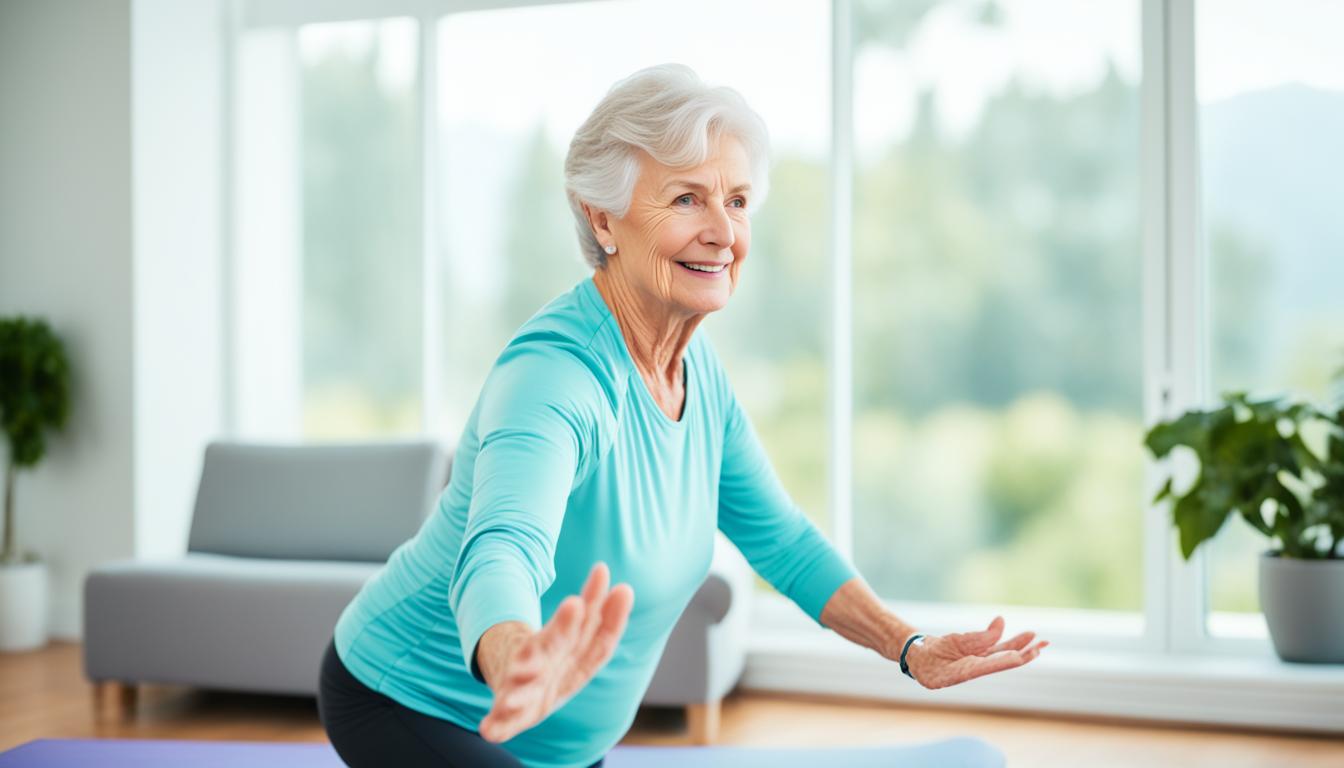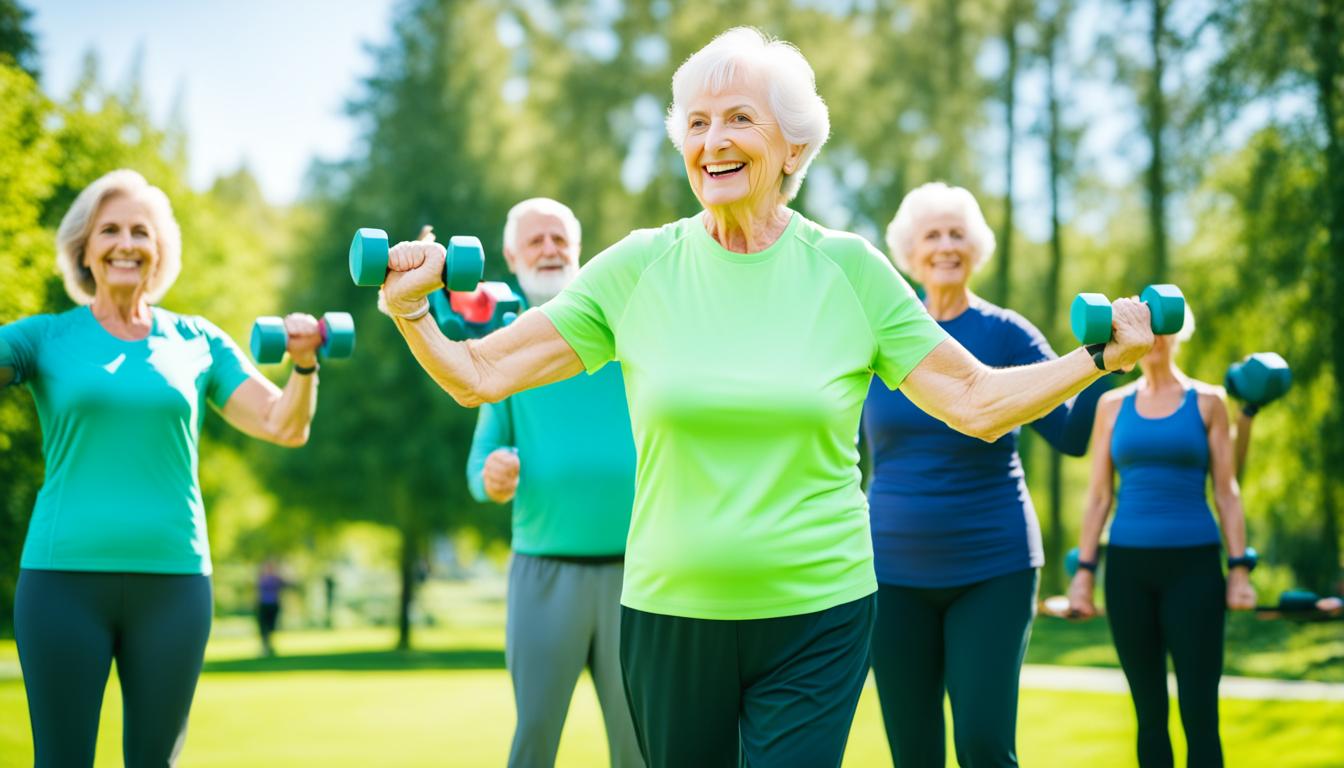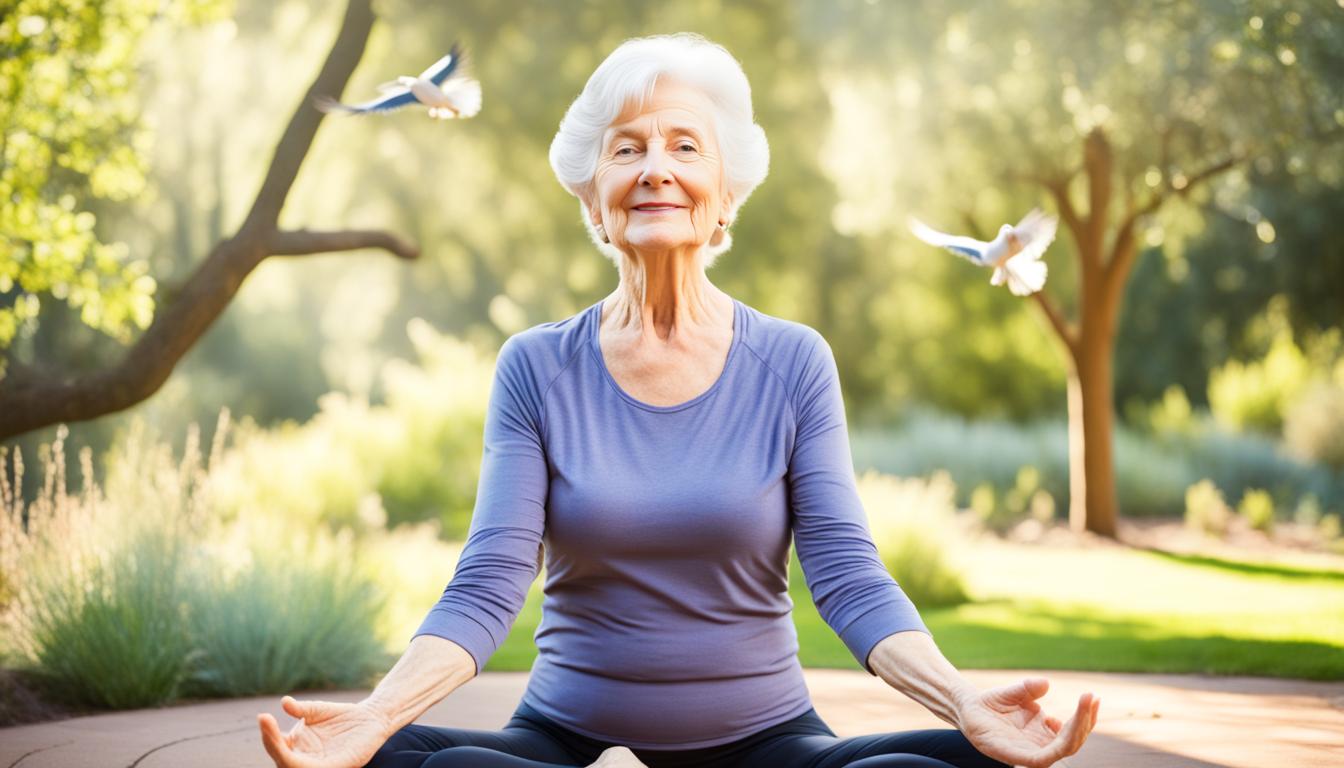As you enter your golden years, maintaining a healthy and active lifestyle is crucial for overall well-being. The good news is that it’s never too late to start prioritizing your fitness. In this guide, we will explore age-appropriate exercises, fitness tips, and workout routines specifically tailored for individuals over 60. Whether you’re a seasoned fitness enthusiast or a beginner, we’ve got you covered.
Key Takeaways:
- Age-appropriate exercises can help improve strength, flexibility, and balance.
- Incorporating regular physical activity and a healthy diet can reduce the risk of falls and injuries.
- Start with light exercises like walking or using resistance bands, and gradually increase the intensity.
- Consider joining exercise classes or partnering with a friend for motivation and social interaction.
- Always consult with your healthcare provider before starting any new exercise program.
The Benefits of Diet and Exercise for Seniors
Diet and exercise are crucial for maintaining good health in older adults. Regular physical activity and a healthy diet can strengthen muscles and bones, reducing the risk of falls and serious injuries. Simple changes, like incorporating fruits and vegetables into your diet and starting with light exercises such as walking or using resistance bands, can have a significant impact on your overall well-being.
As you age, it’s important to prioritize your health and fitness. Engaging in regular exercise can help improve your mobility, flexibility, and balance, making everyday activities easier and reducing the risk of injury. Pairing exercise with a nutritious diet can further enhance your overall well-being and quality of life.
Exercise for elderly beginners doesn’t have to be intimidating or strenuous. Gentle exercises such as walking, swimming, and cycling are low-impact and can be easily incorporated into your daily routine. These activities can help improve cardiovascular health, boost mood, and increase energy levels.
In addition to exercise, making healthy dietary choices is equally important. Incorporating fruits, vegetables, whole grains, and lean proteins into your meals can provide essential nutrients that support your overall health. These nutrient-dense foods can help maintain a healthy weight, prevent chronic diseases, and improve digestion.
When starting a new exercise or dietary routine, it’s important to consult with your doctor, especially if you have any underlying medical conditions. They can provide guidance tailored to your specific needs and ensure that you’re engaging in activities that are safe and effective for you.
Remember, it’s never too late to start caring for your health and well-being. By incorporating age-appropriate exercises and adopting a balanced diet, you can enhance your physical and mental vitality, allowing you to enjoy an active and fulfilling life in your senior years.
Tips for a Healthy Diet
Making small changes to your diet can have a big impact on your health. Start by incorporating whole foods into your meals, such as fresh fruits, vegetables, and whole grains. Opt for low-fat alternatives to your favorite snacks and increase your fiber intake to promote healthy digestion. Consider following the Mediterranean diet, which emphasizes fish, fruits, vegetables, and whole grains while limiting meat, dairy, and sweets.

Age-Appropriate Exercises and Workout Routines
Exercise doesn’t have to be daunting or strenuous. When it comes to senior fitness, it’s important to find activities that are suitable for your age and fitness level. By incorporating age-appropriate exercises into your routine, you can stay active, improve your strength and flexibility, and enhance your overall well-being.
To start, consider incorporating 20 to 30 minutes of aerobic exercise into your daily routine. Activities such as walking, swimming, or cycling are excellent options that get your heart pumping and help improve cardiovascular health. Not only does aerobic exercise benefit your heart, but it can also boost mood and increase energy levels.

In addition to aerobic exercise, it’s important to include strength training exercises in your workout routine. Using light weights or resistance bands, perform exercises that target major muscle groups such as the legs, arms, and core. Strength training helps improve muscle strength, maintain bone density, and reduce the risk of falls and fractures.
To improve balance and proprioception, consider incorporating exercises such as yoga or tai chi. These activities help enhance stability, coordination, and body awareness. They are gentle on the joints and can be modified to suit different fitness levels, making them ideal for older adults.
Remember, the key is to find activities that you enjoy and that suit your fitness level. Whether it’s dancing, gardening, or playing a sport, engage in activities that keep you motivated and make exercise a regular part of your routine. Don’t forget to listen to your body and rest when needed.
“Exercise is a celebration of what your body can do. Not a punishment for what you ate.” – Women’s Health
Getting Started with Exercise
Before embarking on any exercise program, it is essential to prioritize your health and safety. Consulting with your doctor, especially if you have underlying medical conditions, is crucial for a successful and safe fitness journey.
To begin your exercise routine, it is important to warm up your muscles and prepare your body for physical activity. Start with a warm-up session that includes stretching exercises to improve flexibility and prevent injuries.
Gradually increasing the intensity and duration of your workouts is key to making progress and avoiding overexertion. For beginners, short walks or gentle movements are a great way to build strength and endurance. As your fitness level improves, you can gradually introduce more challenging exercises.
Exercising with a partner or joining a group can provide motivation, support, and make your workouts more enjoyable and social. Consider participating in group fitness classes, walking clubs, or finding a workout buddy who shares your fitness goals.

Monitoring Progress and Effectiveness of Workouts
To track your progress and ensure that your workouts are effective, it’s important to use the right tools and techniques. By monitoring various aspects, such as steps, workout duration, exercise intensity, and overall improvements, you can make necessary adjustments to your routine for optimal results.
One useful tool for tracking your steps is a pedometer or an activity tracker. These devices can count your steps and give you a clear picture of your daily activity level. By aiming for a certain number of steps each day, you can actively work towards your fitness goals.
Timers are another valuable tool for measuring workout duration. Whether you’re lifting weights, doing cardio, or practicing yoga, setting a timer can help you stay focused and complete your exercises within the desired time frame.
Journals can also play a vital role in monitoring your progress. By recording your exercises, including the types of workouts, sets, repetitions, and weights used, you can easily track your performance over time. Additionally, jotting down any notes or observations can help you identify patterns and make necessary adjustments to your routine.
Heart rate monitoring is crucial for understanding exercise intensity. You may use a heart rate monitor or simply learn to measure it manually. By checking your heart rate during workouts, you can gauge the intensity of your exercises and ensure that you’re working within a target range suitable for your fitness level.
If you’re not feeling any fatigue or noticing improvements in your overall fitness, it may be time to increase the intensity of your workouts. Challenge yourself by adding more weight, increasing your sets or repetitions, or trying more advanced variations of your exercises. However, it’s important to listen to your body and avoid pushing yourself too hard, as overexertion can lead to injuries.
Adjustments for Aging Bodies
As we age, our bodies may require adjustments to our exercise routines. It’s important to be mindful of your body’s limitations and listen to any pain or discomfort. Instead of pushing through, try modifying your workouts to suit your needs. Avoid high-impact exercises that can strain your joints, and focus on incorporating low-impact activities that are gentler on the body.
One excellent low-impact exercise option for seniors is swimming. Not only is it easy on the joints, but it also provides a full-body workout. Consider joining a local swim club or signing up for water aerobics classes to make it enjoyable and social.
Another adjustment to consider is incorporating more cardio exercises into your routine. Cardiovascular health is essential for overall fitness, and activities such as brisk walking, cycling, or dancing can help maintain a healthy heart and lungs. Remember to start slowly and gradually increase the intensity of your cardio workouts.
Hydration and a balanced diet are also crucial factors to consider for overall health. Drink plenty of water throughout the day to stay properly hydrated, especially if you’re engaging in physical activity. Additionally, maintaining a well-balanced diet that includes nutrient-rich foods like fruits, vegetables, whole grains, lean proteins, and healthy fats can provide the fuel your body needs to stay fit and strong.
By making these adjustments and listening to your body, you can continue to enjoy the benefits of exercise and maintain your fitness as you age. Remember, it’s never too late to start or modify your workout routine to best support your health and well-being. Stay active, stay healthy, and embrace the positive impact of exercise on your life.
Conclusion
Staying fit after 60 is entirely possible with the right approach. By incorporating age-appropriate exercises, maintaining a healthy diet, and adjusting your workouts to suit your needs, you can embrace active aging and improve your overall well-being. It’s important to remember that before starting any exercise program, it’s crucial to consult with your doctor to ensure it is safe for you.
Monitoring your progress and making adjustments along the way is also important. You can use tools such as pedometers or activity trackers to keep track of your steps and timers to measure the duration of your workouts. Keep a journal to record your exercises and monitor your heart rate to gauge the intensity.
With dedication and consistency, you can stay fit and enjoy a fulfilling and healthy life after 60. Don’t be discouraged by age or limitations – there are exercises and modifications available for individuals of all fitness levels. Remember, health and fitness are lifelong journeys, and by taking care of yourself, you can continue to stay active and vibrant well into your senior years.
FAQ
What are age-appropriate exercises for seniors?
Age-appropriate exercises for seniors may include walking, swimming, low-impact cardio exercises, strength training using light weights or resistance bands, and activities that improve balance and proprioception like yoga or tai chi.
How can I start incorporating exercise into my routine as a senior?
Start by incorporating 20 to 30 minutes of aerobic exercise, such as walking or swimming, into your routine. Gradually increase the intensity and duration of your workouts, and consider exercising with a partner or joining a group for motivation and social interaction.
What are some tips for a healthy diet as a senior?
Some tips for a healthy diet as a senior include incorporating whole foods into your meals, like fresh fruits, vegetables, and whole grains. Opt for low-fat alternatives to your favorite snacks and increase your fiber intake. Consider following the Mediterranean diet, which emphasizes fish, fruits, vegetables, and whole grains while limiting meat, dairy, and sweets.
How can I monitor my progress and the effectiveness of my workouts?
You can monitor your progress and the effectiveness of your workouts by using tools such as pedometers or activity trackers to monitor your steps, timers to measure workout duration, and journals to record your exercises. You can also monitor your heart rate during workouts to gauge the intensity and adjust accordingly.
What adjustments should I make to my exercise routine as I age?
As you age, it’s important to be mindful of your body’s limitations and listen to any pain or discomfort. Avoid high-impact exercises that may cause joint strain and focus on low-impact exercises like swimming. Incorporate more cardio exercises to maintain cardiovascular health, and remember to stay hydrated and maintain a balanced diet for overall health.
Source Links
- https://familydoctor.org/healthy-habits-at-age-60-and-beyond/
- https://www.menshealth.com/uk/fitness/a39380571/how-to-stay-fit-at-60/
- https://health.clevelandclinic.org/60-told-exercise-best-tips-get-started


